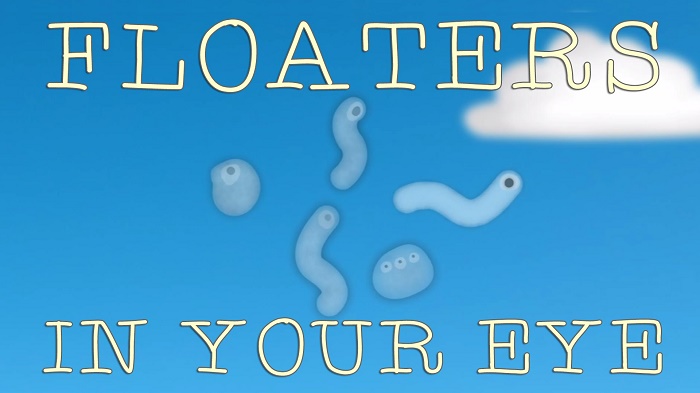To understand where they come from, it helps to bone up on a little ocular anatomy. At the front of your eye is the cornea, and behind it you can find the pupil (the dark centre of your eye) and the iris (the colourful fringe around the pupil). Between the two lies a small reservoir of liquid called the aqueous humour.
A layer of light-sensitive cells lining the back of your eye is called the retina. When the neurons that form the retina become excited by light, they send messages through the optic nerve and into the brain, relaying information about just what it is you’re seeing. But between the lens and the retina lies an ocean of liquid referred to as vitreous humour, vitreous gel, or sometimes just vitreous.
 ""
""As we grow older, small shadows can cause floaters in the jelly-like vitreous in front of the retina
The vitreous is a clear, colourless mass of mostly water with a jelly-like consistency. Unlike the aqueous humour, the vitreous humour never gets replenished. You will die, essentially, with the same vitreous humour with which you were born. That means that if some external object gets washed into the vitreous – blood or other cells, for example – then they’ll stay there. And when those little bits of ocular detritus block light passing through the eye, they cast tiny shadows onto the retina. Those shadows are what we perceive as eye floaters.
As we age, some of the jelly-like substance naturally collapses and becomes runnier. And when that happens, the few solids that are scattered throughout the vitreous can clump together. They, too, can project small shadows onto your retina, which likewise become perceived as floaters.
Based on optometrists’ reports, it’s a fairly common phenomenon. According to one UK study, each optometrist can expect an average of 14 patients per month complaining of floaters. Another study used a smartphone app to assess the prevalence of floaters in the general population. Out of 603 Android users, about 446 or 74% reported floaters. But only about a third of them complained about detrimental effects on their vision.
Since most people either learn to live with the condition or the floaters eventually disappear, most researchers and practitioners consider the condition to be benign.
Controversial treatments
But for others, the phenomenon can lead to more serious distress or impairment, or it can be a herald for future problems. The sudden and intense onset of floaters in older people, for example, can suggest something called posterior vitreous detachment or PVD, the separation of the vitreous humour from the retina.
PVD can then lead to retinal tearing and, eventually, to blindness. A recent Journal of the American Medical Association study found that patients with an acute onset of floaters referred to ophthalmologists had a 14% likelihood of having a retinal tear. That’s high enough that such patients “should be triaged for urgent ophthalmologic assessment.”
Despite the fact that for most folks the condition is not problematic, a cursory internet search yields a plethora of treatment ideas, ranging from the nonsensical (yoga) to the plausible but invasive (surgery). Particularly worrisome are treatment options presented that sound plausible enough, like using a yttrium aluminium garnet (YAG) laser, a tool that’s become commonplace in ophthalmology, but which do not yet have much empirical support or approval by the US Food and Drug Administration.
 ""
""Sudden onset of eye floaters can mean serious problems, such as the separation of the vitreous from the retina
Indeed, researchers David Sendrowski and Mark Bronstein write in the journal Optometry that there’s “little clinical research” devoted to investigating the potential use of a YAG laser for the condition, and while a handful of studies have found it to be a safe procedure, it only led to “moderate” improvements, and even then only in a third of patients.
A rather more well-accepted procedure, for patients who have so many floaters that their vision becomes impaired, is called a vitrectomy, which involves replacing the vitreous humour with a saline solution. But because vitrectomies carry their own set of serious risks, including retinal tears and cataracts, they’re usually thought of as a last resort and only when floaters seriously disrupt a patient’s vision.
For most people, “conventional management of most vitreous floaters typically requires only reassurance and education,” write Sendrowski and Bronstein. A 2012 study by Italian researchers underscores this point: many of us think of persistent eye floaters as more of a nuisance than as a condition that requires treatment.
For most people, we may notice them from time to time, especially while gazing against a clear blue sky where they’re most noticeable, and think them curious or puzzling... until they fade or disappear from both our vision and our attention.
















































